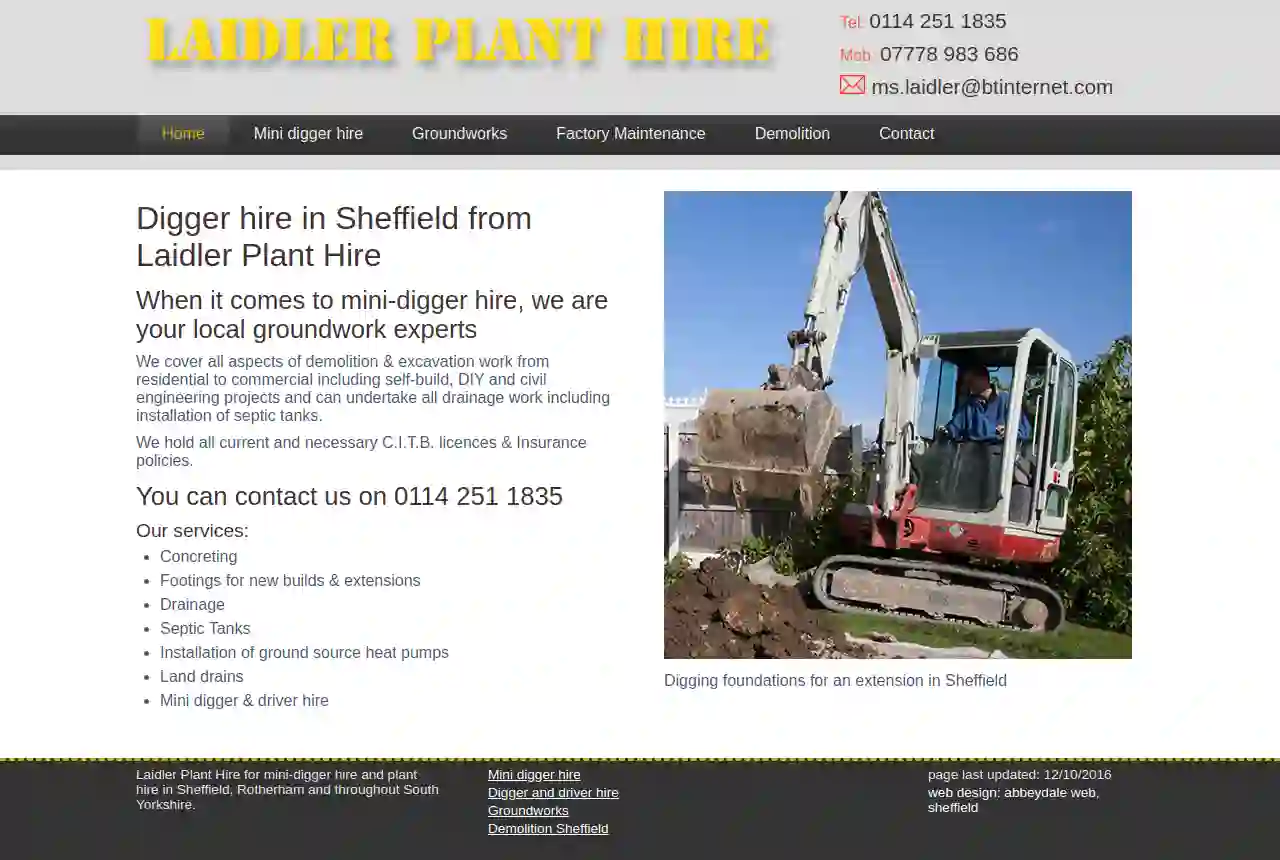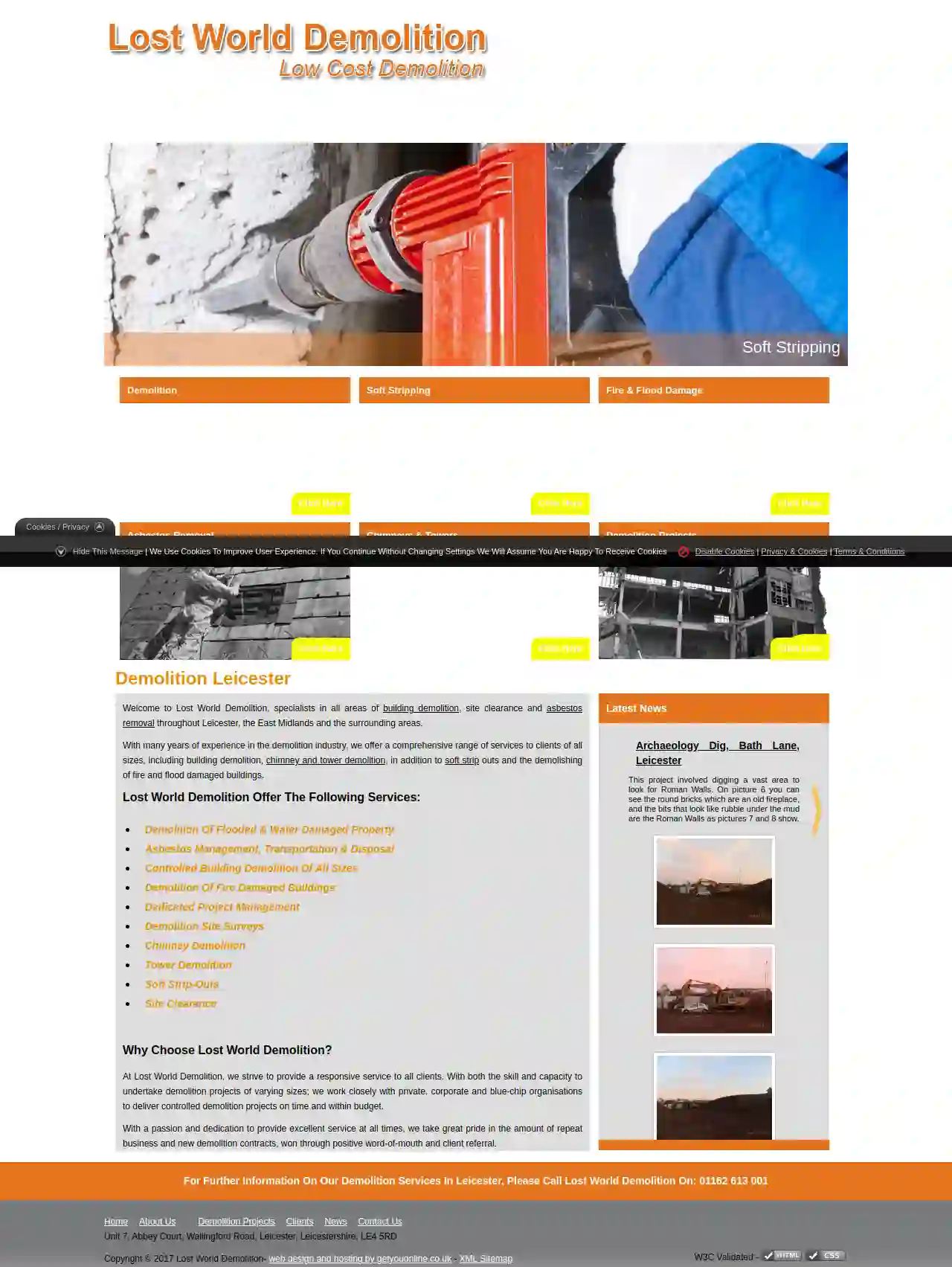Excavation Contractors Swanwick
Top Land Excavation in Swanwick
Receive 3 FREE Excavation Contractors quotes for your project today! Compare profiles, reviews, accreditations, portfolio, etc... and choose the best service.

G R Day Operated Mini Diggers, Extension Bases and Excavations.
525 reviews18 nesfield close, alvaston, derby, derbyshire, Derby, DE24 0QT, GBAbout G. R. Day With over 20 years of experience, G. R. Day offers a reliable and professional service. Fully insured and CPCS qualified, there's not much Gavin hasn't done on a digger. He has a variety of attachments for his machines, including land rakes, riddle buckets, ripper teeth, and grabble thumbs. He also has concrete breakers to make light work of breaking out concrete drives, concrete bases, and existing footings. Why Choose G. R. Day? Over 20 years of experience DBS Checked Fully insured CPCS qualified Professional and reliable Get in touch for your free, no-obligation quote today.
- Services
- Why Us?
- Our Team
- Testimonials
- Gallery
Get Quote
LA Landscaping Services LTD
Derby, GBDerbyshire Landscaping Co: Your Trusted Partner for Garden Transformation Derbyshire Landscaping Co is a network of professional landscaping and gardening companies serving all areas in Derbyshire. We are dedicated to providing personalized services to both residential and commercial clients, whether it's a one-off project or an ongoing annual maintenance contract. We cater to everyone's needs and budget, ensuring there's no job too big or too small for us. Our approved panel of members are committed to providing fully transparent information to customers throughout all projects. We believe in building trust and ensuring complete satisfaction, so no project is considered complete until you are 100% happy with the results. We understand that your outdoor space is an extension of your home, and we are passionate about creating beautiful and functional gardens that you can enjoy for years to come. Whether you're looking to create a space for entertaining, relaxing, or simply adding character to your property, our members can design and personalize the area to meet your specific needs. Our services include: • Fencing & Gates • Landscaping for Domestic & Commercial Clients • Artificial Grass • Wood Decking Installation • Patios, Block Paving • Water Features • Soil Conditioning (e.g., Fertilization) • Planting • Garden Clearance • Topsoil • Supply And Erect Garden Furniture/Storage • Weed Spraying • Decking to Relax With Guests • Fencing • Plus much more… Why Choose Derbyshire Landscaping Co? • **Attention to Detail:** Our members have a keen eye for detail, ensuring the best possible results time after time. We believe the difference between good and exceptional is attention to detail. • **Quality Assured:** Our approved panel of members will deliver unparalleled results, as they do not accept sub-standard work. • **Customer Service:** Our members' friendly and knowledgeable customer service teams are always happy to help. Make your enquiry today to arrange your free consultation. Investing in landscaping can significantly increase your property value. A well-landscaped home typically benefits from an increase of 5.5 - 12.7% in value, depending on the type of landscaping used. Contact our members at Derbyshire Landscaping Co today for more information or to arrange a free quotation.
- Services
- Why Us?
- Gallery
Get Quote
Laidler Plant Hire Ltd
1 Upperthorpe Rd, Killamarsh Sheffield, South Yorkshire, 1 Upperthorpe RdKillamarsh Sheffield, Sheffield, S21 1EQ, GBLaidler Plant Hire: Your Local Groundwork Experts in Sheffield When it comes to mini-digger hire, Laidler Plant Hire is your trusted partner for all your groundwork needs in Sheffield and surrounding areas. We offer a comprehensive range of services, from residential and commercial demolition and excavation to self-build, DIY, and civil engineering projects. Our expertise extends to drainage work, including the installation of septic tanks, and we are fully equipped to handle all your ground source heat pump installations and land drain requirements. We are committed to providing high-quality services and hold all necessary C.I.T.B. licenses and insurance policies, ensuring your peace of mind. Our team of experienced professionals is dedicated to delivering exceptional results, exceeding your expectations on every project. Contact us today for a free quote and let us help you bring your vision to life.
- Services
- Why Us?
- Our Team
- Gallery
Get Quote
RMS Building & Landscaping LTD
539 reviews30 Clumber Avenue, Brinsley, Nottingham, NG16 5BT, GBProfessional, Reliable and Friendly, Nottingham Builder and Landscaper RMS Building & Landscaping is a friendly and approachable Nottingham builder & Landscaper offering a variety of landscaping, bricklaying and exterior cleaning services to both residential and commercial clients. We pride ourselves on offering a professional and reliable service allowing us to deliver an exceptionally high standard of work resulting in consistently happy and satisfied customers. Given our ability to meet and exceed the needs of our clients, it’s no wonder that more than 80% of our work comes from word of mouth and recommendations from our existing customer base. With years of experience in the building trade, if you’re looking for a Nottingham builder to help you achieve your building, landscaping or pressure cleaning needs – no matter the size, no job is too small – then simply get in contact for a free quotation.
- Services
- Why Us?
- Testimonials
- Gallery
Get Quote
A.C Building Services
520 reviews11 Sunny Bank, Worksop, S81 0BG, GBAbout A.C Building Services A.C Building Services pride ourselves on quality, reliability and good customer relations. We are fully qualified and you can find us on Rated People and Yell.com where you can check our ratings. A.C Building Services have a history of very happy customers and references can be provided. We help customers decide on the best actions to take on the job they want doing to all manner of budgets. We also are approved damp proofing & timber treatment contractors. If you’re looking for or require something specialised, please don’t hesitate to contact us.
- Services
- Why Us?
- Gallery
Get Quote
Leicester Demolition & Dismantling Ltd
51 reviewsUnit 7, Abbey Court, Unit 7 Abbey Court Wallingford Road Leicester Leicestershire, Leicester, LE4 5RD, GBWelcome to Lost World Demolition, specialists in all areas of building demolition, site clearance and asbestos removal throughout Leicester, the East Midlands and the surrounding areas. With many years of experience in the demolition industry, we offer a comprehensive range of services to clients of all sizes, including building demolition, chimney and tower demolition, in addition to soft strip outs and the demolishing of fire and flood damaged buildings. Lost World Demolition Offer The Following Services: Demolition Of Flooded & Water Damaged Property Asbestos Management, Transportation & Disposal Controlled Building Demolition Of All Sizes Demolition Of Fire Damaged Buildings Dedicated Project Management Demolition Site Surveys Chimney Demolition Tower Demolition Soft Strip-Outs Site Clearance Why Choose Lost World Demolition? At Lost World Demolition, we strive to provide a responsive service to all clients. With both the skill and capacity to undertake demolition projects of varying sizes; we work closely with private, corporate and blue-chip organisations to deliver controlled demolition projects on time and within budget. With a passion and dedication to provide excellent service at all times, we take great pride in the amount of repeat business and new demolition contracts, won through positive word-of-mouth and client referral.
- Services
- Why Us?
- Gallery
Get Quote
Dean O'Neill Grab and JCB Hire - Nottingham & Mansfield
53 reviewsMansfield, GBAbout Us My company name is Dean O’Neil Grab and JCB Hire Ltd. I cover Nottingham, Derby and Leicestershire areas to provide the best possible service to my customers and clients. My business is operated to serve both residential and commercial contracts in the above mentioned East Midlands. Dean O’Neill Started working with his Dad many years ago when he was just 14. He worked his way up his fathers company by working in land scaping, fencing and patio and paving. Working hard and learning the ropes for the next 10 years Dean had learded all the main aspects of his Dads company. In this time Dean had moved on to pricing and quoting as well as completing the work as his Dad slowed down a little. Dean decided to widen his skills and went down the academic route at Basford Hall College to qualify in Brick laying and plastering to NVQ level 3. Moving on he trained further and now works as a qualified JCB driver with his CITB licence. He also oporates a 360egree machine above 5 tonne. Dean and his family have working links to Nottingham for over 80 years through Mapperley Landscapes and O’Neill tippers.
- Services
- Why Us?
- Our Team
- Gallery
Get Quote
PAVE WISE
3.37 reviews27 Cherry Orchard Mount, Nottingham, NG55TQ, GBWelcome to Pave Wise Based in Nottingham, Pave Wise are the No. 1 installers for driveways, patios and landscaping in Nottingham. We take great pride in providing a quality bespoke service whether laying a new driveway, patio or working on a landscaping project for residential or commercial customers. If you’re looking for block paving, gravel, resin bond or Tarmacadam get in touch, we promise you a competitive quote! We welcome any customer to inspect our past projects, to see first hand our high standards of workmanship. YOUR FIRST CHOICE FOR PAVING - LANDSCAPING - FENCING We use the best materials at every price point. You can be sure of a topnotch job whatever your budget. Driveways For Every Home When you choose a driveway contractor, you want to be certain you choose the right company that has the right skills and professionalism. The company that you choose must be reliable, trustworthy and dedicated to complete the work to your total satisfaction and within your budget and timescale. Our expert installers will walk you through the entire process. We begin with our initial, no charge, consultation. Once we have a good idea of your needs, we will begin drafting a design. This will include the materials used and advise the time frame of your project. Once we can agree on all parameters of your project, we get to work! Our staff is courteous, not only to you, but also your needs and your neighbors. We do our best to make sure your work is done professionally and quickly. Our speed is due to our high level of expertise. Rest assured, we do not cut corners on any project. The Benefits Improve the character of your home Add value to your property High quality material used Work fully insured and guaranteed for many years Complete customer satisfaction Range of colours, designs and patterns to choose from Completely free survey Free written quotation
- Services
- Why Us?
- Testimonials
- Gallery
Get Quote
Aggrecom Ltd
3.69 reviewsPlot 2, Foundry Park, Crompton RoadIlkestonDerbyshire, Foundry ParkCrompton RoadIlkestonDerbyshire, Ilkeston, DE7 4BG, GBAggrecom Ltd: Your Trusted Partner for Earthmoving, Plant Hire & Aggregates With over 30 years of collective experience, Aggrecom Ltd has established itself as a leading provider of construction materials and services in the East Midlands. We are renowned for our commitment to quality, reliability, and customer satisfaction. Our fleet of modern 8-wheel tipper lorries, road sweepers, and earthmoving equipment ensures that we can handle any project, big or small, delivering on time and within budget. We are dedicated to providing a comprehensive range of services, including: • Earthmoving • Aggregates • Road Sweeper Hire • Grab Hire • Plant Hire • Transport • Recycling • Mini Digger Hire At Aggrecom, we are 100% customer-focused. Our team of experienced professionals is dedicated to providing personalized attention and expert guidance throughout your project. We take pride in our attention to detail and strive to exceed your expectations. We operate across the East Midlands, serving Derbyshire, Nottinghamshire, Leicestershire, Lincolnshire, Staffordshire, South Yorkshire, and Warwickshire. Contact us today to discuss your project needs and let us help you achieve your goals.
- Services
- Why Us?
- Gallery
Get Quote
Martyn Wright Plant Hire & Groundworks
51 reviewsChurch View, Hartington Buxton Derbyshire, Church View Hartington Buxton Derbyshire, Buxton, SK17 0AW, GBWelcome to Martyn Wright Plant Hire & Groundworks Martyn Wright Plant Hire & Groundwork is a small, family-run business that provides plant equipment, for hire and sale across Derbyshire, Staffordshire and all surrounding areas. From small, domestic projects to large, commercial projects, we can supply you with a vast array of diggers, telescopic handlers, excavators tracked and wheeled and other access equipment. Our plant hire fleet comprises one of the widest ranges of equipment across the Midlands, England. With over 25 years experience, our friendly staff are fully qualified and experienced in plant machinery and groundwork contracting, We have established great working relationships with our suppliers and we understand the machinery and its requirements more than any other competitor. Our commitment and approach Our aim is simple - to give you the best plant equipment and the best support at the most competitive prices. Works carried out by our team of experienced digger operators come with a guarantee, ensuring at all times they are clean, tidy, well presented and adhere to Health and Safety policies. To enable us to carry out works for any client, we operate within all legal requirements, holding Public Liability Insurance, registered with CITB. We understand that all works cannot be planned well in advance and that situations may arise for a quick response. Martyn Wright Plant Hire have fast become a contractor recognised for quality and efficiency. Whether you know what you require, or need some more help and advice, we take care of everything, to make your life easy.
- Services
- Why Us?
- Gallery
Get Quote
Over 13,059+ Excavation Businesses on our directory
Our excavation providers operate in Swanwick & surrounding areas!
ExcavationHQ has curated and vetted Top Excavation Companies arround Swanwick. Find a reliable contractor today.
Frequently Asked Questions About Excavation Contractors
- Basement Size: The larger the basement, the more excavation is required, increasing the cost.
- Soil Type: Excavating rocky or dense clay soil is generally more expensive than loose soil.
- Accessibility: Difficult-to-access sites might require specialized equipment or more labor, driving up costs.
- Foundation Type: The chosen foundation type (full basement, crawl space, slab) affects excavation needs.
- Underpinning: If underpinning (strengthening existing foundations) is necessary, it significantly increases costs.
- Disposal Fees: Hauling excavated soil to disposal sites adds to the overall expense.
- Project Size and Scope: The larger and more complex the excavation, the higher the cost.
- Soil Type: Different soil types require different equipment and techniques, impacting costs. Rocky or clay-rich soil can be more expensive to excavate than loose soil.
- Accessibility: Difficult-to-access sites might require specialized equipment or additional labor, increasing expenses.
- Disposal Costs: Hauling away excavated material (soil, rocks, etc.) to disposal sites incurs additional fees.
- Permits and Inspections: Depending on local regulations, permits and inspections might be required, adding to the overall cost.
- Clear the Area: Remove any obstacles, including vehicles, outdoor furniture, landscaping features, or structures, from the excavation zone and surrounding area.
- Mark Existing Features: Identify and mark underground utilities, septic tanks, sprinkler systems, or other buried elements you want to protect.
- Protect Landscaping: Use tarps or fencing to shield trees, shrubs, gardens, or other landscaping elements from damage.
- Provide Access: Ensure the excavation contractor has clear access to the work area, including gates wide enough for equipment.
- Discuss Logistics: Coordinate with the contractor regarding parking arrangements, material delivery, and any special instructions or concerns you might have.
- Topsoil Removal: Stripping the fertile topsoil layer from a site, often preserving it for landscaping.
- Trench Excavation: Digging long, narrow trenches for utilities (pipes, cables) or foundations.
- Basement Excavation: Removing earth to create a space for a basement beneath a structure.
- Pool Excavation: Digging a precise hole for installing a swimming pool.
- Roadway Excavation: Removing earth and preparing the ground for road construction.
- Demolition Excavation: Clearing debris and preparing the site after demolition.
- Channel Excavation: Creating channels for drainage or irrigation.
How much does it cost to excavate a basement?
How much does excavation cost?
How do I prepare my property for excavation?
What are the different types of excavation?
How much does it cost to excavate a basement?
- Basement Size: The larger the basement, the more excavation is required, increasing the cost.
- Soil Type: Excavating rocky or dense clay soil is generally more expensive than loose soil.
- Accessibility: Difficult-to-access sites might require specialized equipment or more labor, driving up costs.
- Foundation Type: The chosen foundation type (full basement, crawl space, slab) affects excavation needs.
- Underpinning: If underpinning (strengthening existing foundations) is necessary, it significantly increases costs.
- Disposal Fees: Hauling excavated soil to disposal sites adds to the overall expense.
How much does excavation cost?
- Project Size and Scope: The larger and more complex the excavation, the higher the cost.
- Soil Type: Different soil types require different equipment and techniques, impacting costs. Rocky or clay-rich soil can be more expensive to excavate than loose soil.
- Accessibility: Difficult-to-access sites might require specialized equipment or additional labor, increasing expenses.
- Disposal Costs: Hauling away excavated material (soil, rocks, etc.) to disposal sites incurs additional fees.
- Permits and Inspections: Depending on local regulations, permits and inspections might be required, adding to the overall cost.
How do I prepare my property for excavation?
- Clear the Area: Remove any obstacles, including vehicles, outdoor furniture, landscaping features, or structures, from the excavation zone and surrounding area.
- Mark Existing Features: Identify and mark underground utilities, septic tanks, sprinkler systems, or other buried elements you want to protect.
- Protect Landscaping: Use tarps or fencing to shield trees, shrubs, gardens, or other landscaping elements from damage.
- Provide Access: Ensure the excavation contractor has clear access to the work area, including gates wide enough for equipment.
- Discuss Logistics: Coordinate with the contractor regarding parking arrangements, material delivery, and any special instructions or concerns you might have.
What are the different types of excavation?
- Topsoil Removal: Stripping the fertile topsoil layer from a site, often preserving it for landscaping.
- Trench Excavation: Digging long, narrow trenches for utilities (pipes, cables) or foundations.
- Basement Excavation: Removing earth to create a space for a basement beneath a structure.
- Pool Excavation: Digging a precise hole for installing a swimming pool.
- Roadway Excavation: Removing earth and preparing the ground for road construction.
- Demolition Excavation: Clearing debris and preparing the site after demolition.
- Channel Excavation: Creating channels for drainage or irrigation.